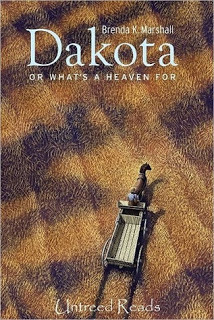Book Review: Dakota, or What's a Heaven For, by Brenda Marshall

Dakota, or What's a Heaven For
Brenda K. Marshall
North Dakota Institute for Regional Studies, 2010
What to make of an old-fashioned telling of a thoroughlymodern story? Brenda Marshall's Dakotamay put off some impatient readers by following certain literary conventions ofthe time about which she is writing (the 1870s)—chapter headings describe whatwill happen in that chapter, for example, and rich exposition helps completethe portrait of the people and landscape of the Dakota Territory—butpersistence will be rewarded. This novel tells a surprising and a compelling storythat you haven't heard before, and it's filled with extraordinarily complex andmemorable characters.
The "Pre-Amble" offers clues as to what the book is about:it's a story of independence. "That narrative of independence remains aspowerful, as false, as necessary as ever in the Dakotas. It has become ourfetish, replacing the lost object of desire, the impossible place that neverwas. You have been told that there is nothing there. I tell you there is toomuch. Even where there is nothing, there is too much of it." This prologue alsogives us a list of the various narrative voices the reader will meet, includingthe book's dominant voice, that of Frances Bingham: "I mean for this to be mystory. It, too, is a story of what a woman's patience can endure, as well as ofwhat a woman's resolution can achieve."
This Frances has married one Percy Bingham in order to benear his sister, Anna, the true object of Frances's desire. Percy, however, isno great catch, although his lack of ambition means that proximity to Anna issecured, even when the family moves from St. Paul to the "Bonanza Farm" ofPercy and Anna's father, John Bingham, who has acquired his stake through hisconnections to the Northern Pacific Railroad. It is there, on the farm, thatFrances discovers her independence, and allows herself to pursue her "object ofdesire." But it is the 1870s, and nothing is very simple. As a woman, one whois more competent than any of the men around her, she cannot easily strike outon her own. She is a wife and is herself an object, no matter how she wouldlike to be defined. When she is rebuffed by Anna, she is reluctant to act whena new desire emerges.
Life is hard in the Dakota Territory, and not just forFrances. Blizzards seem endless, and are followed almost invariably by floodingand disease. Alcoholism is not unusual, and there are other addictions as well.One of the most memorable characters in the book is Little Carl, who harbors ashocking secret. There is also Jack Shaw, a Russian Jew who abandons the swamp landhis community bought, believing the marketing hype about the golden prairie.There is manipulative J.B. Power, an executive of the Northern PacificRailroad, the driving force behind the settlement of the territory. There isAlexander McKenzie, the scheming businessman who bends everyone, includingpoliticians and businesspeople, to his will, who has his sights set on Frances.And there is sweet Kirsten, the Norwegian girl who learns, even better thanFrances, how to survive on her own.
Frances, though, is the heart of the story. And while thereader's sympathy is often with her as she battles her drunkard husband, as sheseeks recognition for her skills, as she tries to do right by herless-fortunate neighbors, as she copes with her own desires, her struggle forindependence reveals her imperfections. She is, ultimately, selfish, and forthat she pays a high price—and learns a very hard lesson.
But the book is also a story of the Dakota Territory, andthe author's command of its history is truly impressive. It's well worthreading.
Published on November 18, 2011 09:05
No comments have been added yet.



